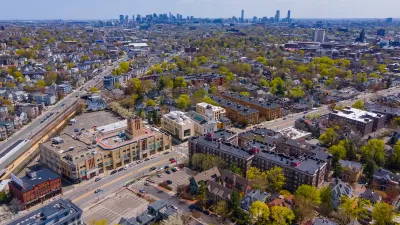Charles Marohn proposes height limits as a catalyst for development. Yes, you read that correctly.

Marohn's argument begins with the example of Sarasota, Florida, where the cost of land is a barrier to small-scale, incremental development. Marohn explains that despite the demand for growth, cities artificially inflate the cost of land by allowing high-density, tall projects next to vacant lots and strip malls. The effect of so much helter-skelter development, according to Marohn: "A small number of people will sell their vacant lots at a premium. The development on these lots will absorb the latent demand. Everyone else with a vacant lot will wind up with nothing – no demand, no sale – and, in the interim, any incremental development will be stifled, along with any naturally-occurring redevelopment (non-subsidized)."
After noting that before the "suburban experiment" development occurred incrementally: "Cities matured by moving to the next plateau of financial value, growing incrementally up, incrementally out and becoming incrementally more intense." To mimic a more natural process of incrementalism, Marohn suggests height restrictions as a regulatory mechanism preferable to zoning codes: "I would allow the next increment of development, but nothing more…. Something simple: The maximum building height shall be two stories or 1.5 times the average height of the directly adjacent buildings, whichever is greater."
*This post was updated 11/3/2014 with the proper spelling of the author's name.
FULL STORY: A Case for Height Restrictions

Maui's Vacation Rental Debate Turns Ugly
Verbal attacks, misinformation campaigns and fistfights plague a high-stakes debate to convert thousands of vacation rentals into long-term housing.

Planetizen Federal Action Tracker
A weekly monitor of how Trump’s orders and actions are impacting planners and planning in America.

In Urban Planning, AI Prompting Could be the New Design Thinking
Creativity has long been key to great urban design. What if we see AI as our new creative partner?

King County Supportive Housing Program Offers Hope for Unhoused Residents
The county is taking a ‘Housing First’ approach that prioritizes getting people into housing, then offering wraparound supportive services.

Researchers Use AI to Get Clearer Picture of US Housing
Analysts are using artificial intelligence to supercharge their research by allowing them to comb through data faster. Though these AI tools can be error prone, they save time and housing researchers are optimistic about the future.

Making Shared Micromobility More Inclusive
Cities and shared mobility system operators can do more to include people with disabilities in planning and operations, per a new report.
Urban Design for Planners 1: Software Tools
This six-course series explores essential urban design concepts using open source software and equips planners with the tools they need to participate fully in the urban design process.
Planning for Universal Design
Learn the tools for implementing Universal Design in planning regulations.
planning NEXT
Appalachian Highlands Housing Partners
Mpact (founded as Rail~Volution)
City of Camden Redevelopment Agency
City of Astoria
City of Portland
City of Laramie





























